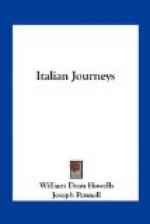III.
Parma is laid out with a regularity which may be called characteristic of the great ducal cities of Italy, and which it fully shares with Mantua, Ferrara, and Bologna. The signorial cities, Verona, Vicenza, Padua, and Treviso, are far more picturesque, and Parma excels only in the number and beauty of her fountains. It is a city of gloomy aspect, says Valery, who possibly entered it in a pensive frame of mind, for its sadness did not impress us. We had just come from Modena, where the badness of our hotel enveloped the city in an atmosphere of profound melancholy. In fact, it will not do to trust to travellers in any thing. I, for example, have just now spoken of the many beautiful fountains in Parma because I think it right to uphold the statement of M. Richard’s hand-book; but I only remember seeing one fountain, passably handsome, there. My Lord Corke, who was at Parma in 1754, says nothing of fountains, and Richard Lasells, Gent., who was there a century earlier, merely speaks of the fountains in the Duke’s gardens, which, together with his Grace’s “wild beasts” and “exquisite coaches,” and “admirable Theater to exhibit Operas in,” “the Domo, whose Cupola was painted by the rare hand of Corregio,” and the church of the Capuchins, where Alexander Farnese is buried, were “the Chief thing to be seen in Parma” at that day.
The wild beasts have long ago run away with the exquisite coaches, but the other wonders named by Master Lasells are still extant in Parma, together with some things he does not name. Our minds, in going thither, were mainly bent upon Correggio and his works, and while our dinner was cooking at the admirable Albergo della Posta, we went off to feast upon the perennial Hash of Frogs in the dome of the Cathedral. This is one of the finest Gothic churches in Italy, and vividly recalls Verona, while it has a quite unique and most beautiful feature in the three light-columned galleries, that traverse the facade one above another. Close at hand stands the ancient Baptistery, hardly less peculiar and beautiful; but, after all, it is the work of the great painter which gives the temple its chief right to wonder and reverence. We found the fresco, of course, much wasted, and at first glance, before the innumerable arms and legs had time to order and attribute themselves to their respective bodies, we felt the justice of the undying spite which called this divinest of frescos a guazzetto di rane.




